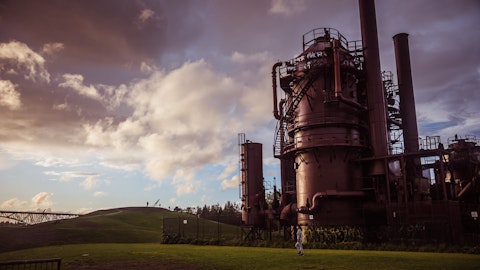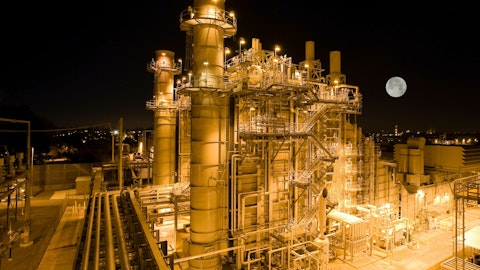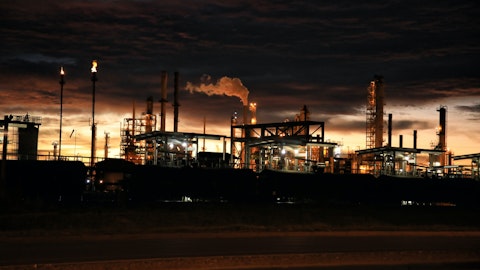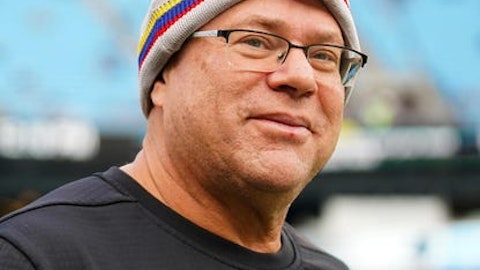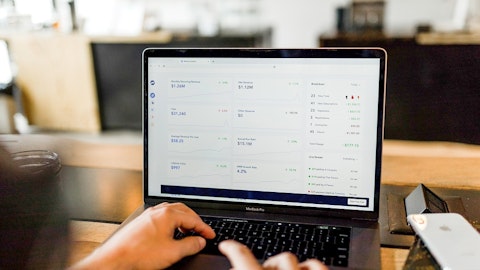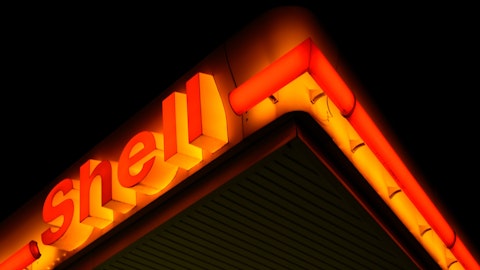Antero Resources Corporation (NYSE:AR) Q4 2022 Earnings Call Transcript February 16, 2023
Operator: Greetings, and welcome to the Antero Resources Fourth Quarter 2022 Earnings Call. At this time all participants are listen-only mode. . As a reminder, this conference is being recorded. I would now like to turn the conference over to your host, Brendan Krueger, Vice President of Finance for Antero Resources. Thank you. You may begin.
Brendan Krueger: Good morning. Thank you for joining us for Antero’s fourth quarter 2022 investor conference call. We’ll spend a few minutes going through the financial and operating highlights, and then we’ll open it up for Q&A. I would also like to direct you to the homepage of our website at www.anteroresources.com, where we have provided a separate earnings call presentation that will be reviewed during today’s call. Today’s call may contain certain non-GAAP financial measures. Please refer to our earnings press release for important disclosures regarding such measures, including reconciliations to the most comparable GAAP financial measures. Joining me on the call today are Paul Rady, Chairman, CEO and President; Michael Kennedy, CFO; Dave Cannelongo, Senior Vice President of Liquids Marketing and Transportation; and Justin Fowler, Senior Vice President of Natural Gas Marketing and Transportation. I will now turn the call over to Paul.
Paul Rady: Thank you, Brendan. I’d like to start by highlighting the significant transformation that Antero underwent during 2022. Let’s start with Slide 3, which summarizes the consistent and repeatable results that we delivered throughout the year. The top of the slide illustrates our continued focus on debt reduction. During 2022, we reduced our total debt by approximately $1 billion. Since the beginning of our debt reduction program in the fourth quarter of 2019, we have now reduced debt by over $2.5 billion. Because of this conservative approach to debt reduction, we were able to shift our capital allocation towards increasing cash returns to our shareholders. As you can see on the bottom of the slide, we purchased over 25 million shares, representing 1% of the total shares outstanding.
To expand on Antero’s consistent and repeatable business model, let’s discuss our land and acquisition strategy on Slide 4 titled Organic Land Acquisitions. Over the last few years, we witnessed an increase in both public and private corporate M&A as commodity prices increased. Meanwhile, Antero remained focused on our core acreage footprint with a particular emphasis on organic lease acquisitions. As opposed to larger transactions that can dilute our equity and add absolute debt, our strategy has been focused on organically acquiring acreage within our core position in Appalachia. This has allowed us to dollar cost average across commodity cycles and acquire acreage near our proven well results. During 2022, Antero’s organic leasing program added approximately 80 drilling locations at an average cost of less than $1 million per location, more than offsetting our maintenance capital plan that assumes an average of 60 to 65 wells per year.
Now let’s turn to Slide number 5 to discuss Antero’s differentiated strategy. The churn at the top highlights our absolute debt reduction since 2019 compared to our peers. Our disciplined corporate strategy of prioritizing debt reduction differentiates Antero versus peers that have increased their absolute debt levels, primarily as a result of corporate M&A. With our debt initial target already achieved, we are well positioned to maintain a balanced debt reduction and return of capital program going forward. This is important, especially in light of the recent fallback in natural gas prices. The chart in the middle of the page illustrates the percentage of natural gas sold out of basin. We sell a 100% of our natural gas outside the Appalachian Basin, including 75% into the LNG fairway, where we capture premiums to NYMEX.
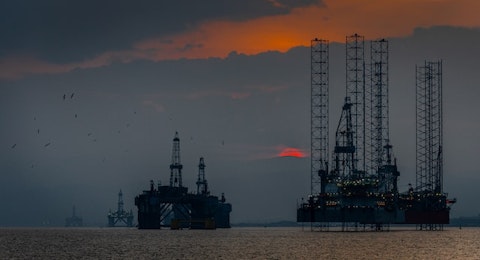
Photo by Ben Wicks on Unsplash
The majority of our peers have significant exposure to local markets that trade at levels as low as $1.25 back of NYMEX. These markets are particularly at risk in times of increasing storage levels where price is the only mechanism to force shut-ins. The chart at the bottom of the page highlights our diversified product mix with nearly half of our revenue coming from liquids production. The uplift we received from our liquid sales, combined with our premium priced natural gas, provides better stability and predictability in financial and operating results through the different commodity cycles. Now to touch on the current liquids and NGL fundamentals, I will turn it over to our Senior Vice President of Liquids Marketing and Transportation; Dave Cannelongo, for his comments.
David Cannelongo: Thanks, Paul. Despite recent headwinds for liquids prices, overall macroeconomic factors are pointing to price improvement and the recovery of fundamentals through this year. Main demand driver will be China’s reopening, which is taking place faster than originally expected due to the relaxing of their COVID-Zero policy. In addition, growth in PDH capacity points to stronger U.S. exports in 2023. At the same time, the U.S. supply forecast revisions loom with recent reductions in natural gas and oil prices, setting up a potential bullish picture exiting this year and into 2024. U.S. propane exports are expected to increase 10% year-over-year to 1.5 million barrels per day in 2023 shown on Slide number 6 titled U.S. Propane Exports Rebounding.
The additional export volume will be more than met by an additional 46 VLGC carriers that will be added this year. This is a recent record high in VLGC fleet development back to 2016. Turning to Slide number 7 titled Global LPG Exports and NGL Production. The graph on the left highlights that the marginal LPG exporter has been the United States. The trend is expected to continue as increasing petrochemical and res/com demand will need to be met with U.S. exports. U.S. propane export terminals utilization rates are expected to remain elevated but adequate as witnessed already in Q1 2023 to satisfy the call on U.S. LPG. Antero’s anchor position on Mariner East will allow us to continue to play an active role in supplying this global LPG pool as the largest U.S. producer exporter.
The chart on the right shows that while the rest of the world NGL supply growth will be relatively flat, the U.S. is expected to increase production year-over-year by 6% in 2023 and 5% in 2024. However, supply growth forecast could be in flux, especially considering the recent lower associated natural gas prices. Domestic economic factors in China point to expected recoveries in the property and pet-chem markets that should drive demand from suppressed levels seen during the enactment of their COVID-Zero policies. PDH build-out and increasing utilization are expected to be seen as early as the end of Q1 2023. Steadily declining LPG refinery yields in China will also have buyers increasingly looking to imports for their barrels. Turning to the next slide.
Planned PDH build-out in China and other key markets is set to add approximately 700,000 barrels per day of increased feedstock demand exclusively for propane. Notably, the demand ramp will be first seen in 2023 compared to the relatively slow demand uptick that was seen in PDH capacity through 2022 as some of these facilities started to come online and others were delayed into this year. I’ll end my remarks with the recognition that 2022 had some unexpected headwinds starting in the spring with extended pandemic-related lockdowns, inflation and its cooling effect on the global economic stability and growth. We maintain that long-term trends show demand for LPG increasing throughout the decade and beyond, while prospects of sustainable supply growth appear unrealistic, given challenges from underinvestment in hydrocarbons and depleting poor U.S. shale inventory.
With that, I will turn it over to Mike.
Michael Kennedy: Thanks, Dave. I’ll start on Slide number 9 titled Absolute Debt and Leverage Reduction. Following the successful debt reduction program over the last several years, Antero is now in the strongest financial position in company history, by total debt below $1.2 billion and leverage down to just 0.4 times. Assuming today’s strip prices, we still expect to generate over $500 million of free cash flow, and our leverage remains comfortably under one time at year-end 2023. This compares to our peers where leverage fluctuate materially as a result of higher absolute debt levels. In alignment with our lower debt strategy, we continuously look for ways to optimize our business and enhance our margins. During the first quarter of 2023, we executed an early settlement of our 2024 NYMEX gas options for approximately $200 million.
These hedges were put in place several years ago and covered approximately 20% of our 2024 natural gas production at $2.77 per annum. In addition, we also terminated a contract related to an unutilized firm transportation commitment to local Appalachian markets for $24 million. Termination of this contract was completed as a discounted value to commitments through 2025 and reduces net marketing expense by approximately $13 million annually. Provide some additional color on the natural gas macro views and our thought process around the hedge settlement, let’s turn to Slide number 10 titled Free Cash Flow Breakeven. This slide provides a look at the natural gas peer group and the required NYMEX Henry Hub price for each of the peers to achieve an unhedged free cash flow breakeven position in 2023.
In today’s Shale 3.0 world, we believe there is no investor appetite or excess capital available for companies to operate with a cash flow deficit. As illustrated on this page, as a result of higher maintenance capital costs, limited liquids revenue uplift and widening basis differentials on natural gas, we estimate that most Haynesville companies are not able to generate free cash flow in today’s pricing environment. Why is this important? With Appalachia pipelines near maximum capacity and Permian-associated gas being dictated by oil prices, the Haynesville is now the marginal natural gas producing region. The other notable takeaway from this slide is that Antero’s free cash flow breakeven price for natural gas is at the lowest end of the peer group.
The drivers behind this low breakeven price are the significant contribution of liquids to our revenue base, as shown in the chart on the top left and the premium natural gas pricing we receive as evidenced by the chart on the bottom left. Further dive into the macro story on gas, let’s turn to Slide number 11, titled Expected Decline in Activity from The Haynesville. The chart on the top of the slide illustrates the relationship between natural gas prices and the basin’s drilling activity. Since 2011, every time NYMEX Henry Hub prices fell below $3, rig counts and activity in the Haynesville noticeably declined. While we have kept the line at $3 on this chart, it is fair to say, in today’s inflationary environment, the old $3 level is likely now closer to $3.50 to $4.
The chart on the bottom left highlights the change in rig count each time natural gas dropped below $3. On average, rigs declined 60% or 42 rigs through the last three cycles. But the Haynesville now, as the marginal supplier of natural gas and activity expected to fall significantly in the months ahead, is important to review the decline profile of the Haynesville. As displayed on the chart on the lower right-hand side of this page, the estimated annual base decline rates of the Haynesville are materially higher than that of Appalachia. With this being the first downward price cycle in which the Haynesville is the marginal supplier, this would suggest a more rapid supply response following an expected decline in rigs. In closing, the successful execution of Antero’s differentiated business strategy positions us to excel across many commodity price cycles.
Increasing NGL demand through the reopening of China provides a positive backdrop to NGL and propane prices as we move through the year. While it is difficult to predict natural gas prices moving forward, we do expect moderated activity to lead to significant volatility in pricing as natural gas demand grows materially in 2024 and beyond with the second wave of LNG export facilities coming online. With a peer-leading balance sheet and product diversification, we are well positioned to deliver on our maintenance capital plan while continuing to pay down debt and return capital to shareholders. With that, I will now turn the call over to the operator for questions.
See also 11 High Growth IT Stocks to Buy and 16 Biggest Paint Companies in the World.
Q&A Session
Follow Antero Resources Corp (NYSE:AR)
Follow Antero Resources Corp (NYSE:AR)
Operator: Our first question comes from the line of Neal Dingmann with Truist Securities. Please proceed to your question.
Neal Dingmann: Paul, my first question is just really on D&C activity sensitivity. I’m just wondering, obviously, prices — commodity prices can be quite volatile as well as even cost to a degree. So, I’m just wondering given more, I assume, the expectation of both volatility on the price and cost side, how fluid would you anticipate your plan B?
Michael Kennedy: Well, for 2023, Neil, this is Mike, and beyond, where maintenance capital, which is a three-rig program and two completion crews. And with our kind of unconstrained nature, the product diversification that we have, the transport out of the basin and NYMEX hubs throwing our balance sheet. But the first two really allows us to kind of have the lowest breakeven from a free cash flow level. So even at our maintenance capital today and a low commodity price on the natural gas side, we’re generating over $0.5 billion of free cash flow. So, it’s very unlikely that you would ever reach levels where we would be below our maintenance capital level from a cash flow from operations. So, we just don’t see any real commodity price scenario where any realistic one where we would go below our three rig and two completion crew development program.
Neal Dingmann: And then just for you or Paul, just I know occasionally in the past, may not even long ago, you’ll occasionally go up and drill a Utica pad or two. Could you just talk maybe about not just maybe the cadence but specifics on, is that — will that continue to be the case or do you continue to focus those three rigs kind of where they’ve been here in the last couple of months?
Michael Kennedy: Yes. It’s generally, as you know, 90% focused on Marcellus, though we have about one pad a year in our plan going forward in the Utica and that just gives the Marcellus infrastructure a little bit of breathing room and then also fills our REX capacity in the Utica.
Neal Dingmann: Very good. Thanks Mike.
Operator: Our next question comes from the line of Subash Chandra with The Benchmark Company. Please proceed your question.
Subhash Chandra: Good morning. What do you think about now, I guess, your share buyback capacity and appetite, obviously, given commodity prices, but also, I guess, some of this one-off stuff with the swaptions and maybe a stronger lease spend?
Michael Kennedy: Yes. So right now, we have 50% dedicated return of capital. That’s based on that over $0.5 billion of free cash flow. The first call on that free cash flow was the $200 million of the swaption early termination of the swaps and then the $24 million of the transport commitment. So that’s $225 million of it. And then we did have credit facility drawings $35 million at year-end, Subash. So that’s $260 million. So that’s kind of the first call. And then the amounts above that are really what are there for return on capital. So, depending on where commodity prices are, it could be at 50%, it could be more than 50%. We’ll just have to see how the free cash flow generation occurs throughout the year.
Subhash Chandra: Okay. Got it. And on the swaption side, I think there’s still — this was an early termination, there’s still contracts out there. Are you looking to possibly — or can you even terminate those?
Michael Kennedy: We don’t have any hedges left. That was the last of the contracts. You may be referring to what we have from a VPP or the ORRI of Sixth Street, but those aren’t — although we consolidate them on our balance sheet, they’re really not on our account, therefore the VPP buyer and the override buyer.
